Ready to exploring the world of transposition for trumpet? From the grandeur of symphony orchestras to the vibrant energy of jazz bands, the trumpet shines in various settings. It is a prominent member of concert bands, brass bands, chamber ensembles, and marching bands. Additionally, the trumpet plays a pivotal role in big bands, salsa bands, funk bands, and other contemporary music genres.
But being in ensembles means transposition and playing in the right key! So let’s get straight to it with our step-by-step guide to transposition for trumpet.
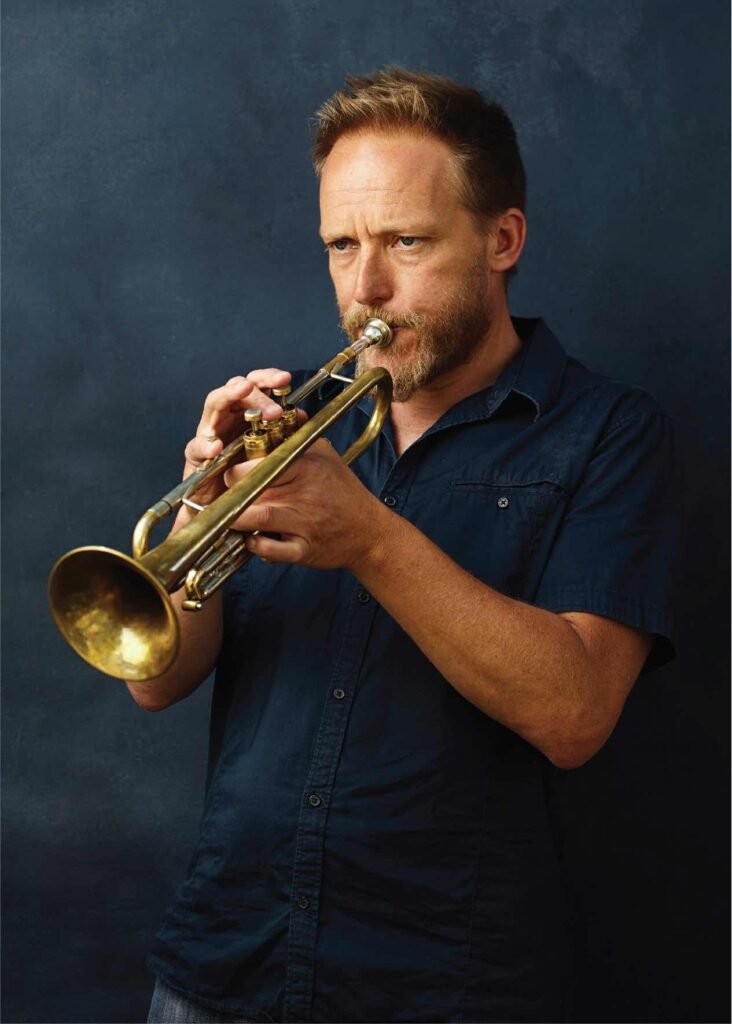
The Trumpet in B flat
One of the challenges of playing the trumpet is transposing the music written for other instruments. Transposing means changing the pitch of a piece of music to make it fit the range or key of another instrument. The trumpet is a transposing instrument in the key of B flat. This means that when the trumpet plays a C on the staff, we hear the Bb below this, or major 2nd below.
If you want to play a piece written for the C flute on the trumpet, you have to transpose it up a major 2nd to make it sound at the same pitch level.

The other trumpets all have their own keys and will also require transposing to play together.
- Bb Trumpet
- C Trumpet
- D/Eb Trumpet
- Piccolo Trumpet
- Cornet
Later in this article we will look at transposing between different trumpets.
Transposition chart for the Trumpet
Here is a handy chart for helping you with transposition for trumpet. You can use it to transpose a single note, for example C to D, or you can use it to transpose the key signature of a piece. For example a piece in D Major would transpose up a major 2nd to E Major.

Transposition for Trumpet to Piano
The piano is a non-transposing instrument, or to put it another way, it is in concert pitch. Whichever notes the pianist reads on the staff, we will hear exactly the same note. As the trumpet is in the key of B flat, we will need to transpose music for the piano up a Major 2nd for the trumpet to play in the same key. Similarly, to play along with the trumpet on the piano, you would need to transpose the music down a major 2nd for the piano part.
The Quickest Method
If you’re not too fussed about understanding the underlying idea of transposition there is a quick trick that trumpet players can use to transpose to C.
- Add 2 sharps to the key signature
- Raise the notes up one position
This is essentially the quickest way to implement Method 2 (see below). It can be used to transpose on the fly whilst playing live or rehearsing.
In this way C major becomes D major, as you have added two sharps. Eb major become Bb major as you have taken away two of the flats (or sharpened them).
Below is the theory behind this method, or why it works.
Transpose Bb to C
The most common trumpet is in B flat as is a transposing instrument. This means that when a player reads a C on the staff and play a C, we hear the Bb below. In other words, their written pitch is a major 2nd above their sounding pitch.
If you play the trumpet and you want to compose music that harmonises with the piano, your sheet music will be a major 2nd above the notes on the piano’s sheet music (or any other non-transposing instrument).
Or you may want to play a trumpet piece on a non-transposing instrument (like the flute). In this case you will have to lower each note a major 2nd (2 half-steps). This will ensure it is heard in the same key as the trumpet.
Steps to Transpose Bb to C
Transposing from Bb to C involves up moving the notes up 2 half-steps or 1 whole-step (tone). This is the same as moving up an interval of a Major 2nd as C natural is the 2nd note in the B flat major scale.
There are two different methods to transpose Bb to C.
Method 1- Move notes up one at a time
Let’s try Method 1 for transposition for trumpet. Have a look at the melody below.

The melody is written in key of D major. We could move all the notes up 2 semitones, making sure that we take into account the F# and C# notes in the original key.
Here is the new melody. As you can see, we now have four sharps, so we are in the key of E Major.

Here is the full transposition with the new key signature.

Method 2 – Transpose the key signature
Here is my preferred method for transposition for trumpet.
- We could move up all the notes up a 2nd
- Transpose the key signature up a major 2nd
- Deal with any notes outside the original key
Look at the melody below.

It is in Eb major so we have Bb, Eb and Ab. First, let’s move all the notes up a 2nd. Intervals always include the starting note so in effect, this means moving up one position on the staff.

Now we can transpose our key signature. The major 2nd above Eb is F natural. Another way to put this is that F is the 2nd note of the E flat major scale. So our new key signature is F Major, which has one flat, Bb.
Here is our transposed melody with the new key signature.

Here is the full transposition with the original and new melodies.
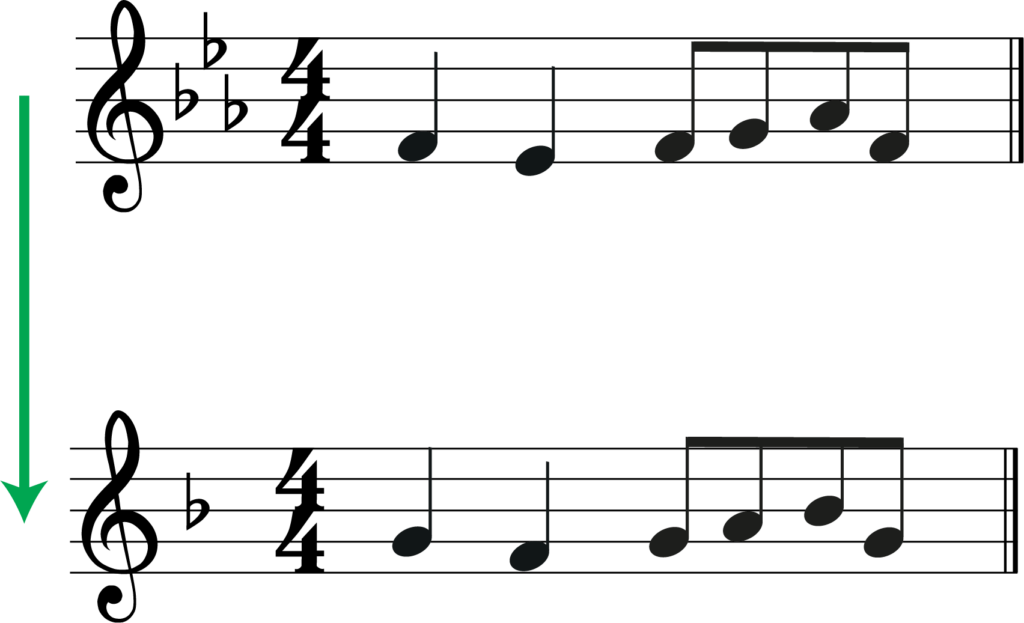
If there were any accidentals that were outside the original key of Eb, we would not use this method. Instead we would treat these as individual notes and transpose them on their own. So if we had a F# then this would move up to G# (2 half-steps above).
How to transpose trumpet to alto sax
The trumpet is in the key of Bb and is a major 2nd below concert pitch. In contrast the alto sax is in Eb. So when the alto sax plays a C we hear the Eb below. This is a major 6th below.
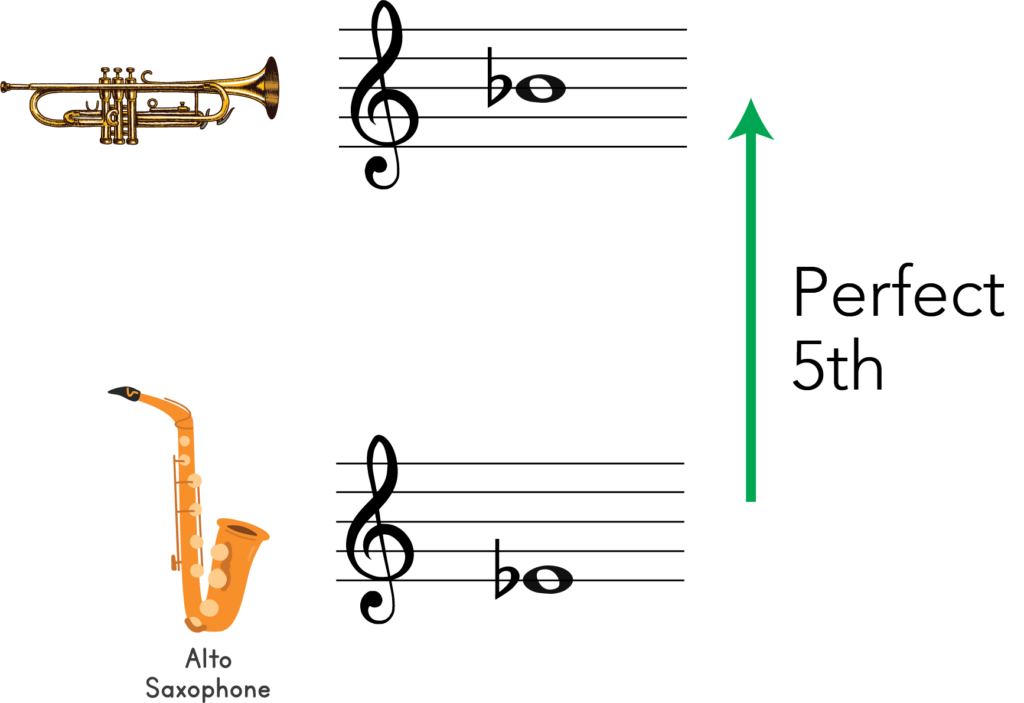
If we want to move between music for the trumpet and alto sax we will be transposing between Eb and Bb, or by a perfect 4th interval.
Transposition for trumpet and alto sax:
- Transpose down a perfect 4th to play trumpet music on the alto sax.
- Transpose up a perfect 4th to play alto sax music on the trumpet.
For more check out our article on transposing down a perfect 4th and transposing up a perfect 4th.
How to transpose trumpet in D to Bb
The standard trumpet is in the key of Bb however the D trumpet is in the key of (you’ve guessed it) D. The trumpet in the key of Eb which is a major 6th below.
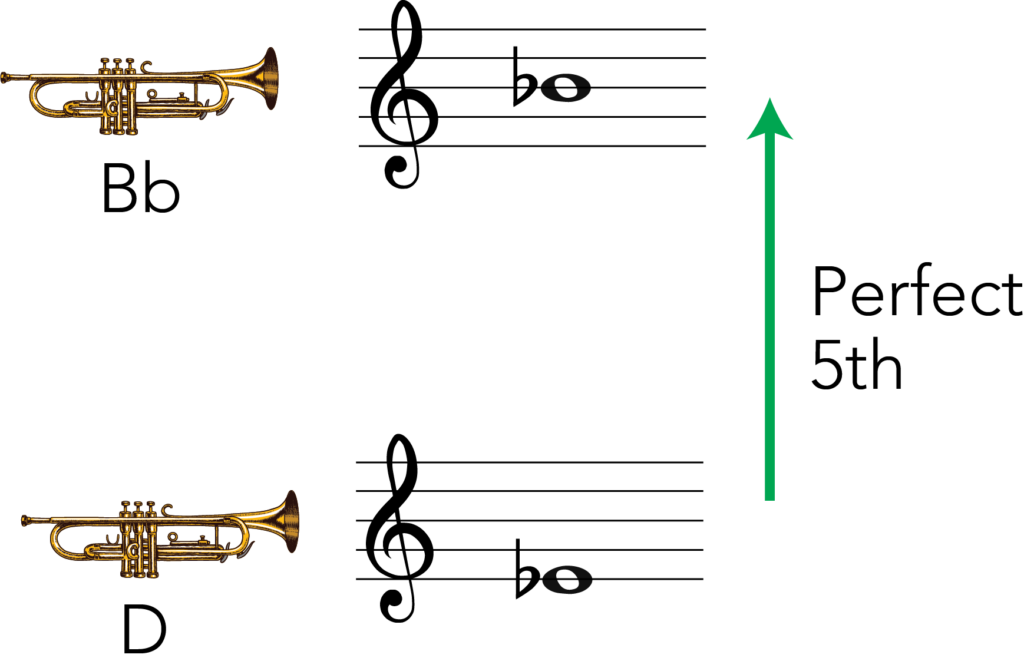
This means that we need to transpose flute music up a major 6th to play it on the alto sax. We could also transpose music for the alto sax down a major 6th to play it on the flute. See our example above for how to transpose by a major 6th.
How to transpose trumpet to trombone
The trombone is in the key of C, so it is not a transposing instrument. This means that we can transpose up and down a Major 2nd to move between the trombone and trumpet.
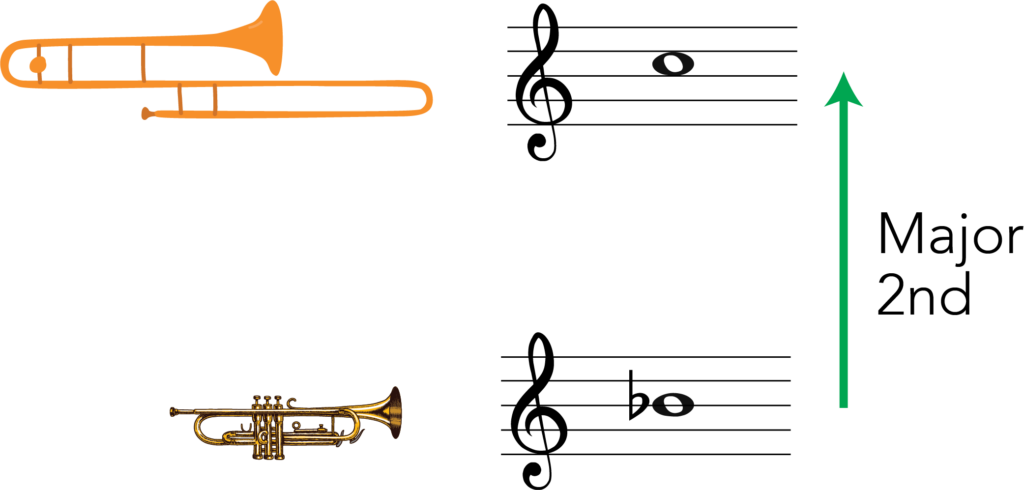
Transposition for trumpet and trombone:
- Transpose up a Major 2nd to play trumpet music on the trombone.
- Transpose down a Major 2nd to play trombone music on the trumpet.
To have both instruments harmonising in the same key, we need the trumpet part to be a major 2nd above the trombone part.
For more on transposing by a major 2nd, check out our two step-by-step guides: transpose up a major 2nd and transpose down a major 2nd.
How to transpose Trumpet to Guitar
The guitar is actually a transposing instrument because its sounding pitch is one octave below its written pitch. This means that when the guitar reads middle C on the stave, we will actually hear the C below this.
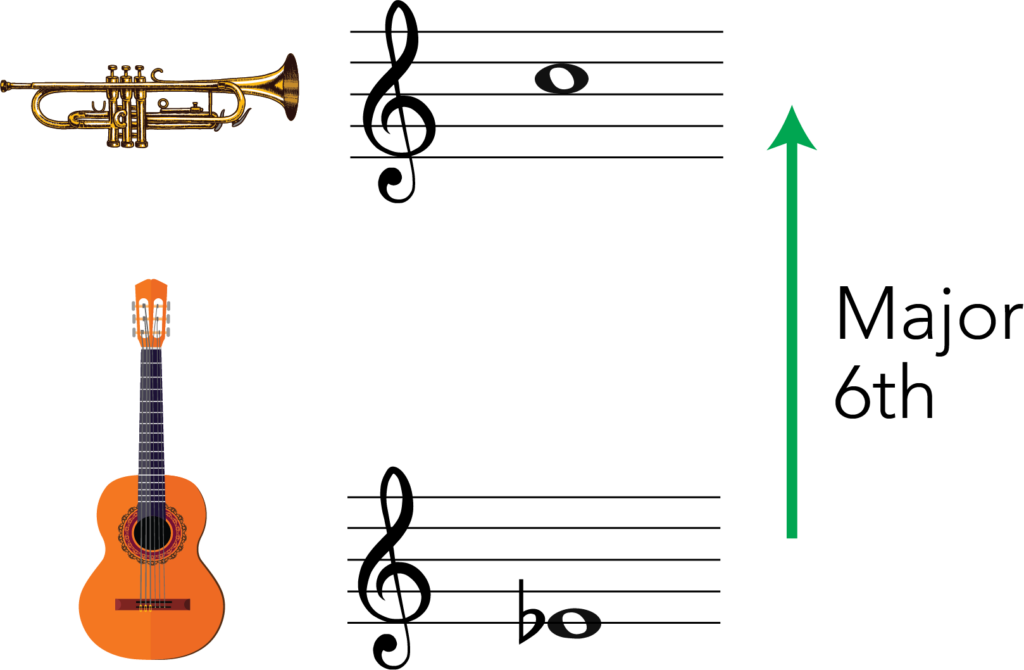
As the trumpet is in Bb, we have the interval of C to the B flat above is a minor 7th. This is because B natural is the 7th note of the C major scale, so if we flatten this note by a half-step we get a Minor 7th.
So why is transposing useful? Well, we might want to play music written for guitar on the trumpet or we might want to write harmonising parts for both instruments. By transposing by a minor 7th we can do this.
It’s work noting that we could transpose by a Major 2nd and both instruments would be playing in the same key, but the guitar would be an octave lower.
Transposition for trumpet and guitar:
- Transpose up a minor 7th to play guitar music on the Bb trumpet.
- Transpose down a minor 7th to play trumpet music on the guitar.
- To have both instrument harmonising in the same key, we need the guitar part to be a minor 7th above the trumpet part.
How to Transpose F to Bb
One reason to transpose F to Bb is that the French Horn is in the key of F. This means that it is a perfect 5th below concert pitch. The trumpet is also a transposing instrument in B flat, so F to Bb gives us an interval of a perfect 4th.
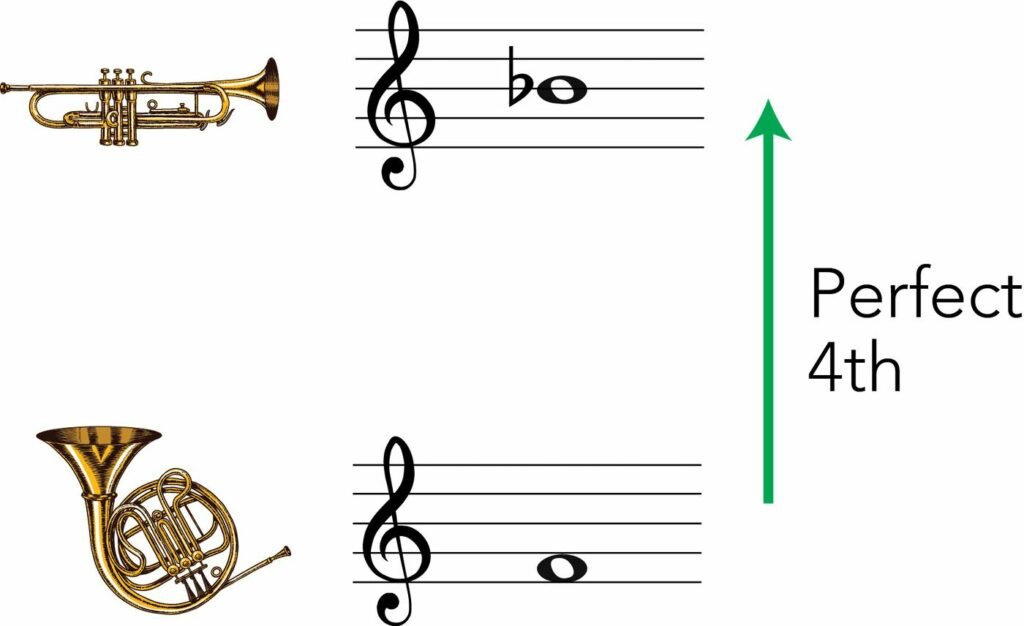
So why is transposing useful? Well, we might want to play music written for French horn on the trumpet or we might want to write harmonising parts for both instruments. By transposing by a perfect 4th we can do this.
- Transpose up a perfect 4th to play trumpet music on the French horn.
- Transpose down a perfect 4th to play French horn music on the trumpet.
- To have both instrument harmonising in the same key, we need the French horn part to be a perfect 4th above the trumpet part.
So how do you transpose by a perfect 4th? We have two step-by-step guides to help: transpose up a perfect 4th and transpose down a perfect 4th.
Using computer software
A far quicker method of transposition is to use software to do it for you! Apps like Musescore, Sibelius and Finale will transpose whole pieces with the press of a few buttons. You can then export, print and share your new transposed sheet music.
What’s next….?
- Check out our guides to transposition
- Learn more about intervals with our guide to compound intervals.
